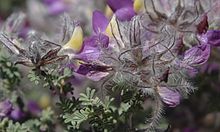| Dalea formosa | |
|---|---|

| |
| Conservation status | |
 Secure (NatureServe) | |
| Scientific classification | |
| Kingdom: | Plantae |
| Clade: | Tracheophytes |
| Clade: | Angiosperms |
| Clade: | Eudicots |
| Clade: | Rosids |
| Order: | Fabales |
| Family: | Fabaceae |
| Subfamily: | Faboideae |
| Genus: | Dalea |
| Species: | D. formosa |
| Binomial name | |
| Dalea formosa Torr. | |
| Synonyms | |
| |
Dalea formosa is a semi-evergreen species of flowering plant in the genus Dalea, known by the common names feather dalea and featherplume; it is named for the physician Samuel Dale. The plant is native to the southern United States. It is highly tolerant of heat, cold, and drought. It is favored by honeybees; but of much less use to most wildlife, with the exception of rabbits and deer. Unique to most plants, it blooms all year long (with the occurrence of monsoon rainfall) and also has a long lifespan.
References
- NatureServe (2024). "Dalea formosa". Arlington, Virginia. Retrieved 4 May 2024.
- "Dalea formosa Torr". Plants of the World Online. Royal Botanic Gardens, Kew. Retrieved 4 May 2024.
- Southwest, The American. "Western USA wildflowers: Feather Peabush, Dalea Formosa". www.americansouthwest.net.
- ^ "SEINet Portal Network - Dalea formosa". swbiodiversity.org.
- "Dalea formosa". Lady Bird Johnson Wildflower Center - The University of Texas at Austin.
- ^ "USDA Plants Database". plants.usda.gov.
- "Plants of Texas Rangelands » Feather Dalea". rangeplants.tamu.edu.
- Xerces Society. Native plants for pollinators and beneficial insects: Southwest - Sonoran Desert Retrieved July 27, 2023
- "Blue Wildflowers - Big Bend National Park (U.S. National Park Service)". www.nps.gov.
- "Dalea formosa, Indigobush, Southwest Desert Flora".
Explanatory notes
- Generally, plants expend considerable energy to bloom and that decreases their lifespan or the duration of their bloom, or both; especially in hot regions. Blooming flowers expend considerable energy through nectar production, water loss via transpiration, and respiration of flower parts (Schoen & Ashman, 1994). “Interestingly, flower lifespan is negatively correlated with temperature; the hotter the environment where they bloom, the shorter the period a plant retains them. The phenomenon has been known for a long time,” comments Shoko Sakai, author of the present study.